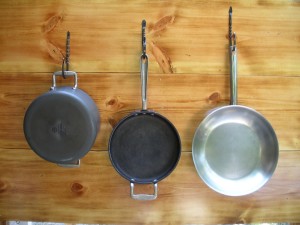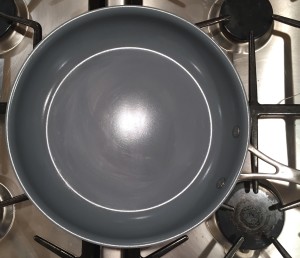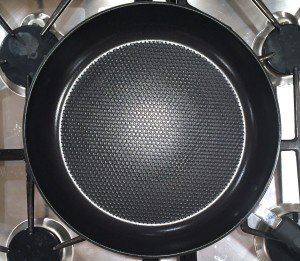My Personal Take On Cookware
 First of all, I highly recommend you go through your cupboards and get rid of any Teflon® skillets and pans you might still have. Knowing all that you know now, there is no way you should continue to cook with them.
First of all, I highly recommend you go through your cupboards and get rid of any Teflon® skillets and pans you might still have. Knowing all that you know now, there is no way you should continue to cook with them.
With that being said, what should you cook with and for what dishes? Here’s my personal insight on what I like to use and think works best for certain foods.
I use the Green Earth Skillet by Ozeri with the Greblon® non-stick coating for fried eggs, omelets, and pancakes. This pan is the most similar to Teflon® but 100% PTFE and PFOA free.
I use the Zwilling J.A. Henckels Twin Spirit Thermolon ceramic Fry Pan for stir-fries, pan seared sea scallops, fish, grilled cheese sandwiches and bacon. The ceramic coating helps prevent sticking but I still use some sort of oil or butter to coat the bottom of the pan.
I use a 10 in. tin coated copper frying pan that I love for fried eggs, searing Ahi tuna, and chicken. I hope to acquire a few more pieces in the future.
I use a Lodge cast iron round fry pan for Tortilla Española (potato pie, my kids’ name for it), cornbread, bacon, sausages, dutch baby pancakes, and paninis.
I use a Le Creuset enameled cast iron dutch oven for chili, soups, stews, roasts, and casseroles. I love my dutch over because you can use it on the stove top and or in the oven.
I use All Clad Stainless Steel cookware for the majority of my pots and pans. Cooking with a stainless steel skillet or frying pan can be intimidating. The trick to preventing foods from sticking is to heat the pan until hot before adding the oil, then add the food. Steel expands when hot and contracts when it comes into contact with a cooler temperature, which is why foods stick to the surface. By adding oil to the pan when it’s hot, the steel becomes static, resulting in a temporarily nonstick surface. I like to sear, braise or brown meat or chicken in my stainless steel skillet.
Hopefully this has given you some insight to help you decide what safe cookware you need for your own kitchen
Bon appétit!
~ Anna


